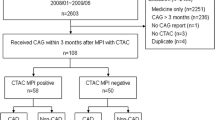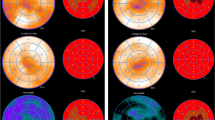Abstract
Background
We evaluated the performance of stress imaging with technetium-99m-labeled tetrofosmin single-photon emission computed tomography (SPECT) and rubidium-82 positron emission tomography (PET) in patients with extreme obesity, defined as body mass index ≥40 kg/m2.
Methods
We identified patients with extreme obesity who underwent angiography in our center and either stress SPECT or PET within the previous six months. Cohorts of patients with extreme obesity and a <5% pretest likelihood of CAD who underwent SPECT (N = 25) or PET (N = 25) were also included.
Results
In total, 108 patients who underwent SPECT (N = 57) or PET (N = 51) were identified. Scan interpretation was classified as definitely normal or abnormal in 83.3% of PET and 60.5% of SPECT scans, respectively (P < .01). PET demonstrated higher diagnostic accuracy and normalcy rate. PET was found to have higher specificity for the pooled cohort. Similar findings were observed using stenosis cut-offs of ≥50% and ≥70%.
Conclusions
In patients with extreme obesity, PET enabled more definitive scan interpretation with less artifact compared to SPECT. PET provided higher diagnostic accuracy and specificity in the detection of obstructive coronary artery disease.

Similar content being viewed by others
Abbreviations
- AC:
-
Attenuation correction
- BMI:
-
Body mass index
- CABG:
-
Coronary artery bypass grafting
- CAD:
-
Coronary artery disease
- PCI:
-
Percutaneous coronary intervention
- PET:
-
Positron emission tomography
- Rb-82:
-
Rubidium-82
- SPECT:
-
Single-photon emission computed tomography
- Tc-99m:
-
Technetium-99m
References
Go RT, Marwick TH, MacIntyre WJ, Saha GB, Neumann DR, Underwood DA, et al. A prospective comparison of rubidium-82 PET and thallium-201 SPECT myocardial perfusion imaging utilizing a single dipyridamole stress in the diagnosis of coronary artery disease. J Nucl Med 1990;31:1899-905.
Bateman TM, Heller GV, McGhie AI, Friedman JD, Case JA, Bryngelson JR, et al. Diagnostic accuracy of rest/stress ECG-gated Rb-82 myocardial perfusion PET: Comparison with ECG-gated Tc-99m sestamibi SPECT. J Nucl Cardiol 2006;13:24-33.
Mc Ardle BA, Dowsley TF, deKemp RA, Wells GA, Beanlands RS. Does rubidium-82 PET have superior accuracy to SPECT perfusion imaging for the diagnosis of obstructive coronary disease?: A systematic review and meta-analysis. J Am Coll Cardiol 2012;60:1828-37.
Twells LK, Gregory DM, Reddigan J, Midodzi WK. Current and predicted prevalence of obesity in Canada: A trend analysis. CMAJ Open 2014;2:e18-26.
Poirier P, Alpert MA, Fleisher LA, Thompson PD, Sugerman HJ, Burke LE, et al. Cardiovascular evaluation and management of severely obese patients undergoing surgery: A science advisory from the American Heart Association. Circulation 2009;120:86-95.
Karason K, Lindroos AK, Stenlöf K, Sjöström L. Relief of cardiorespiratory symptoms and increased physical activity after surgically induced weight loss: Results from the Swedish Obese Subjects study. Arch Intern Med 2000;160:1797-802.
Cox N, Resnic FS, Popma JJ, Simon DI, Eisenhauer AC, Rogers C. Comparison of the risk of vascular complications associated with femoral and radial access coronary catheterization procedures in obese versus nonobese patients. Am J Cardiol 2004;94:1174-7.
Das SR, Alexander KP, Chen AY, Powell-Wiley TM, Diercks DB, Peterson ED, et al. Impact of body weight and extreme obesity on the presentation, treatment, and in-hospital out- comes of 50,149 patients with ST-segment elevation myocardial infarction: Results from the NCDR (National Cardiovascular Data Registry). J Am Coll Cardiol 2011;58:2642-50.
Hibbert B, Simard T, Wilson KR, Hawken S, Wells GA, Ramirez FD, et al. Transradial versus transfemoral artery approach for coronary angiography and percutaneous coronary intervention in the extremely obese. JACC Cardiovasc Interv 2012;5:819-26.
Dunn JP, Huizinga MM, See R, Irani WN. Choice of imaging modality in the assessment of coronary artery disease risk in extreme obesity. Obesity 2010;18:1-6.
Diamond GA, Forrester JS. Analysis of probability as an aid in the clinical diagnosis of coronary-artery disease. N Engl J Med 1979;300:1350-8.
Dilsizian V, Bacharach SL, Beanlands RS, Bergmann SR, Delbeke D, Dorbala S, et al. ASNC imaging guidelines/SNMMI procedure standard for positron emission tomography (PET) nuclear cardiology procedures. J Nucl Med 2016;23(5):1187-226.
Henzlova MJ, Cerqueira MD, Hansen CL, Taillefer R, Yao S. Imaging guidelines for nuclear cardiology procedures: stress protocols and tracers. J Nucl Cardiol 2009;16:331.
Ali I, Ruddy TD, Almgrahi A, Anstett FG, Wells RG. Half-time SPECT myocardial perfusion imaging with attenuation correction. J Nucl Med 2009;50:554-62.
Hansen CL, Goldstein RA, Akinboboye OO, Berman DS, Botvinick EH, Churchwell KB, et al. Myocardial perfusion and function: single photon emission computed tomography. J Nucl Cardiol 2007;14:e39-60.
Renaud JM, Mylonas I, McArdle B, Dowsley T, Yip K, Turcotte E, et al. Clinical interpretation standards and quality assurance for the multicenter PET/CT trial rubidium-ARMI. J Nucl Med 2014;55:58-64.
Kaster TS, Dwivedi G, Susser L, Renaud JM, Beanlands RS, Chow BJ, et al. Single low-dose CT scan optimized for rest-stress PET attenuation correction and quantification of coronary artery calcium. J Nucl Cardiol 2015;22:419-28.
Kaster T, Mylonas I, Renaud JM, Wells GA, Beanlands RS, deKemp RA. Accuracy of low-dose rubidium-82 myocardial perfusion imaging for detection of coronary artery disease using 3D PET and normal database interpretation. J Nucl Cardiol 2012;19:1135-45.
Cerqueira MD, Weissman NJ, Dilsizian V, Dilsizian V, Jacobs AK, Kaul S, et al. Standardized myocardial segmentation and nonmenclature for tomographic imaging of the heart. Int J Cardiovasc Imaging 2002;18:539-42.
Yoshinaga K, Chow BJ, Williams K, Chen L, Garrard L, Szeto ALT, et al. What is the prognostic value of myocardial perfusion imaging using rubidium-82 positron emission tomography? J Am Coll Cardiol 2006;48:1029-39.
Hendel RC, Wackers FJ, Berman DS, Ficaro E, DePuey EG, Klein L, et al. American Society of Nuclear Cardiology consensus statement: Reporting of radionuclide myocardial perfusion imaging studies. J Nucl Cardiol 2006;13:e152-6.
Beller GA, Zaret BL. Contributions of nuclear cardiology to diagnosis and prognosis of patients with coronary artery disease. Circulation 2000;101:1465-78.
Parker MW, Iskandar A, Limone B, Perugini A, Kim H, Jones C, et al. Diagnostic accuracy of cardiac positron emission tomography versus single photon emission computed tomography for coronary artery disease: A bivariate meta-analysis. Circ Cardiovasc Imaging 2012;5:700-7.
Duvall WL, Croft LB, Corriel JS, Einstein AJ, Fisher JE, Haynes PS, et al. SPECT myocardial perfusion imaging in morbidly obese patients: Image quality, hemodynamic response to pharmacologic stress, and diagnostic and prognostic value. J Nucl Cardiol 2006;13:202-9.
Gemignani AS, Muhlebach SG, Abbott BG, Roye GD, Harrington DT, Arrighi JA. Stress-only or stress/rest myocardial perfusion imaging in patients undergoing evaluation for bariatric surgery. J Nucl Cardiol 2011;18:886-92.
Chow BJ, Dorbala S, Di Carli MF, Merhige ME, Williams BA, Veledar E, et al. Prognostic value of PET myocardial perfusion imaging in obese patients. JACC Cardiovasc Imaging 2014;7:278-87.
Hunter CR, Hill J, Ziadi MC, Beanlands RS, deKemp RA. Biodistributon and radiation dosimetry of 82Rb at rest and during peak pharmacological stress in patients referred for myocardiac perfusion imaging. Eur J Nucl Med Mol Imaging 2015;42:1032-42.
Fiechter M, Ghadri JR, Kuest SM, Pazhenkottil AP, Wolfrum M, Nkoulou RN, et al. Nuclear myocardial perfusion imaging with a novel cadmium-zinc-telluride detector: First validation versus invasive coronary angiography. Eur J Nucl Med Mol Imaging 2011;38:2025-30.
Sharma P, Patel CD, Karunanithi S, Maharjan S, Malhotra A. Comparative accuracy of CT attenuation-corrected and non-attenuation-corrected SPECT myocardial perfusion imaging. Clin Nucl Med 2012;37:332-8.
Elhendy A, Schinkel AF, van Domburg RT, Bax JJ, Valkema R, Biagini E, et al. Prognostic stratification of obese patients by stress 99mTc-tetrofosmin myocardial perfusion imaging. J Nucl Med 2006;47:1302-6.
Chow BJ, Abraham A, Wells GA, Chen L, Ruddy TD, Yam Y, et al. Diagnostic accuracy and impact of computed tomographic coronary angiography on utilization of invasive coronary angiography. Circ Cardiovasc Imaging 2009;2:16-23.
Ziadi MC, Dekemp RA, Williams K, Renaud JM, Chow BJ, Klein R, et al. Does quantification of myocardial flow reserve using rubidium-82 positron emission tomography facilitate detection of multivessel coronary artery disease? J Nucl Cardiol 2012;19:670-80.
Ziadi MC, Dekemp RA, Williams KA, Guo A, Chow BJ, Renaud JM, et al. Impaired myocardial flow reserve on rubidium-82 positron emission tomography imaging predicts adverse outcomes in patients assessed for myocardial ischemia. J Am Coll Cardiol 2011;58:740-8.
Acknowledgements
The authors would like to thank Lyanne Fuller BSc and Ann Guo BEng for their assistance with data collection, as well as May Aung CNMT, Kim Gardner CNMT, Patty Irvine CNMT, Monique Pacquette RN, and Patricia Grant RN.
Disclosures
SH reports receiving an honorarium from GE Healthcare. BM was a research fellow support by the Molecular Function and Imaging Heart and Stroke Foundation of Ontario Program Grant (No. PRG6242) and The University of Ottawa Heart Institute’s Whit & Heather Tucker Endowed Research Fellowship in Cardiology Award. BC is University of Ottawa Heart Institute Goldfarb Chair in Cardiac Imaging. RdK is a consultant for and has received grant funding from Jubilant DraxImage. RdK receives revenues from Rubidium-82 generator technology licensed to Jubilant DraxImage and from sales of FlowQuant software. TR has collaborated with and received research funding from GE Healthcare, Advanced Accelerator Applications, and AstraZeneca. BC has received grants from CV Diagnostix and research support from TeraRecon. RB is a Career Investigator supported by the Heart and Stroke Foundation of Canada; the University of Ottawa Heart Institute Vered Chair in Cardiology, and Tier 1 Chair in Cardiovascular Research from the University of Ottawa. RB is or has been a consultant for and receives grant funding from GE Healthcare, Lantheus Medical Imaging, Jubilant DraxImage. None of the other authors had disclosures relevant to this work.
Author information
Authors and Affiliations
Corresponding author
Additional information
The authors of this article have provided a PowerPoint file, available for download at SpringerLink, which summarises the contents of the paper and is free for re-use at meetings and presentations. Search for the article DOI on http://www.SpringerLink.com.
David T. Harnett and Samir Hazra Shared first authors. David T. Harnett was co-supervised by Benjamin Hibbert and Rob S Beanlands. Samir Hazra was supervised by Benjamin Hibbert.
Electronic supplementary material
Below is the link to the electronic supplementary material.
Rights and permissions
About this article
Cite this article
Harnett, D.T., Hazra, S., Maze, R. et al. Clinical performance of Rb-82 myocardial perfusion PET and Tc-99m-based SPECT in patients with extreme obesity. J. Nucl. Cardiol. 26, 275–283 (2019). https://doi.org/10.1007/s12350-017-0855-6
Received:
Accepted:
Published:
Issue Date:
DOI: https://doi.org/10.1007/s12350-017-0855-6




